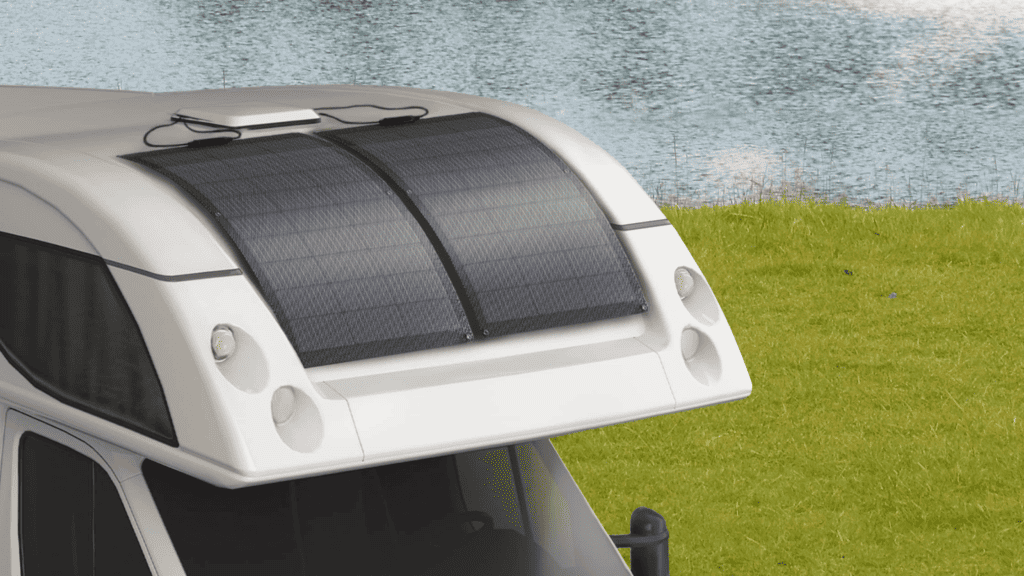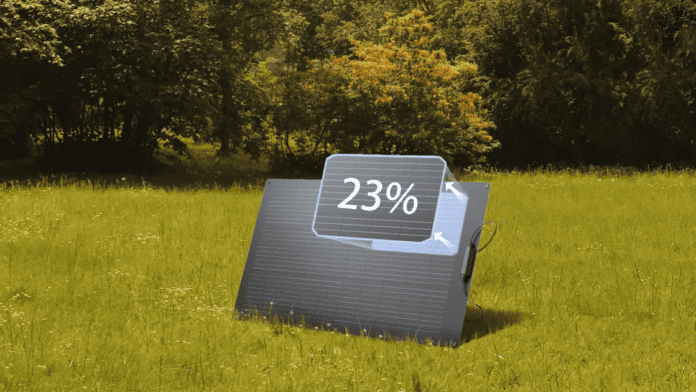Table of Contents
Whether for short road trips or long-term on-the-go living, there’s nothing like traveling in an RV. The open road and endless possibilities for adventure are unparalleled.
Of course, this lifestyle poses some challenges in terms of power generation that solar panels are uniquely positioned to solve. You have access to tons of sunlight, so why not use it to generate electricity to power your appliances?
Obviously, places to mount your solar panels on your RV are in short supply. So, what do you do when you’ve maxed out your solar potential with rigid panels but are still short on meeting your electricity needs?
That’s where flexible solar panels come in!
When you’d like to utilize solar power but lack the flat surface to mount rigid panels, flexible solar panels can be an ideal solution. This type of solar panel is best utilized in conjunction with rigid or portable solar panels, using flexible panels to fill in the gaps left by irregular or curved surfaces.
Let’s break down the flexible solar panels best suited for RV and outdoor use.

Types of Flexible Solar Panels for RVs
When it comes to installing flexible solar panels on your RV, you have three options: monocrystalline, polycrystalline, and thin film.
But which one should you get?
Below, we’ll cover each type, how they’re manufactured, and their efficiency ratings.
Monocrystalline Panels
Monocrystalline solar panels are made from monocrystalline solar cells. Each monocrystalline solar cell that makes up a panel is manufactured in a lab by growing silicon crystal into a log shape and then slicing the log or ingot into multiple thin octagonal discs.
Monocrystalline cells are created expressly to be part of the solar encasement for a monocrystalline solar panel.
The octagonal shape of the solar cells helps to fit a maximum number of solar cells in the array with little to no wasted space. These black-colored solar cells have an efficiency rating between 15% and 20%.
EcoFlow’s flexible solar panels are monocrystalline, offering the best in terms of efficiency rating and lifespan.
Polycrystalline Panels
Polycrystalline encasements are panels made from polycrystalline solar cells, and similar to monocrystalline solar cells, they are made from silicone crystals.
The main difference between monocrystalline and polycrystalline cells is that polycrystalline cells are made from many silicon cells rather than just one, as in the case of monocrystalline cells. The final product takes up more space and provides less efficiency.
Although polycrystalline has a lower efficiency rate than monocrystalline, between 13% and 16%, polycrystalline panels are much cheaper and easier to produce.
Thin Film Panels
Thin film panels are a budget-friendly option that requires less material, contains fewer toxic elements (except for the Cadmium Telluride variety), and generates less waste.
Thin film cells can be made using various materials such as amorphous silicon, cadmium telluride, and copper indium gallium selenide.
Here‘s a brief description of these three main material types.
- Amorphous Silicon: Amorphous silicon is a non-crystalline form of silicon solar cell that’s much easier to produce compared to mono or polycrystalline solar cells. Amorphous silicon is the most common material type used to produce thin film panels.
- Cadmium Telluride: Cadmium Telluride thin film is made from a special chemical compound that’s excellent at capturing sunlight and turning it into energy. The main drawback of this type of thin film solar cell is that Cadmium is extremely toxic, and tellurium is very rare and difficult to mass produce.
- Copper Indium Gallium Selenide: Copper Indium Gallium Selenide solar cells are made by placing layers of each material atop one another to create a semiconductor that can efficiently convert sunlight into energy.
Since thin film is typically the easiest and fastest solar panel type to manufacture, and the efficiency rates continue to increase for these panel types, thin film panels are expected to continue to grow in popularity and use.
What Is the Best Type of Flexible Solar Panel for RVs?
If you’re looking for the best type of flexible panel to enjoy renewable energy on your RV, then you should opt for monocrystalline panels.
Although more expensive, monocrystalline contains the highest efficiency rating compared to every other type of flexible panel available on the market, allowing you to charge up faster.
That’s why you should consider flexible panels like EcoFlow’s 100W Flexible Solar Panels — which boasts an impressive 23% efficiency rating — for your RV.
Let’s say you’re taking your RV out for a camping trip and bringing along your EcoFlow RIVER 2 Pro to keep your essentials charged. If you had two 100W flexible panels affixed to your RV, you could charge up your portable power station (with a capacity of 768Wh) after just four hours of peak sunlight.
Of course, it’s recommended to use flexible panels to augment traditional rigid solar panels whenever possible, especially if you’re living the RV life full-time. In that case, you might want to take things a step further with EcoFlow Power Kits.
Either way, flexible solar panels can help you make the most of irregular surfaces and help you generate the electricity you need to power your lifestyle.
Why Are Monocrystalline Flexible Panels the Most Suitable Option?
When it comes to the best solar panels to affix to curved or irregular surfaces, Monocrystalline flexible solar panels come out on top over their polycrystalline and thin film counterparts.
Let’s delve into some of the biggest advantages this type of panel offers over the alternatives:
Efficiency
Efficiency rating is essential when dealing with limited space, like the roof of an RV, and you need to maximize the amount of energy that can be produced per square foot.
Flexible monocrystalline panels can maximize surface area by conforming to irregularly shaped surfaces where you can’t install traditional rigid panels. At the same time, by using monocrystalline, you can ensure you’re producing the maximum amount of solar energy possible with the amount of space you have to work with because of their higher efficiency rating.
Life span
In general, monocrystalline solar panels tend to last longer than their polycrystalline and thin film counterparts.
Flexible solar panels come with a lower lifespan in general, typically lasting between 15 to 25 years (compared to the 25 to 40 years you’d expect from a rigid panel). By opting for a monocrystalline option, you’re likely to get the most life out of your flexible solar panel compared to one made of a different material and end up on the higher end of that 15 to 25 year spectrum.
The longer your solar panel lasts, the bigger your return on investment will be as it has more time to generate electricity and save you money on energy costs, giving you more time to enjoy savings after the solar payback period.
Frequently Asked Questions
Monocrystalline flexible solar panels are the best option for RVs — these panels offer higher efficiency ratings and also boast a longer life span. This does come with a higher price tag, but it also results in more savings over time as each panel will produce more electricity. Whenever possible, it’s best to opt for monocrystalline solar panels as they produce better results.
Final Thoughts
Considering flexible solar panels for your RV installation? Monocrystalline panels offer higher efficiency ratings and lifespan than polycrystalline or thin film options, meaning they generate more electricity for longer!
Want to generate as much electricity as possible next time you hit the road?
Check out what EcoFlow has to offer today!
